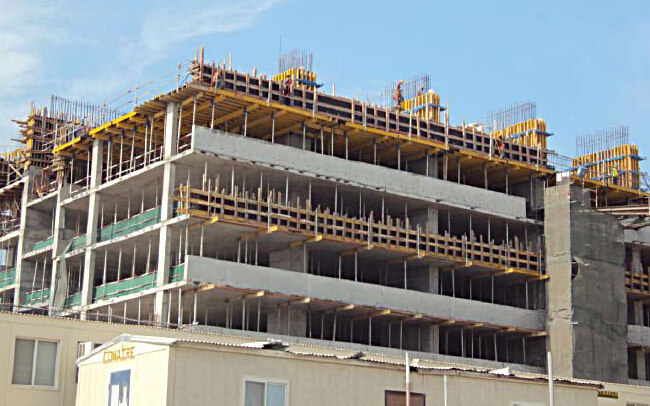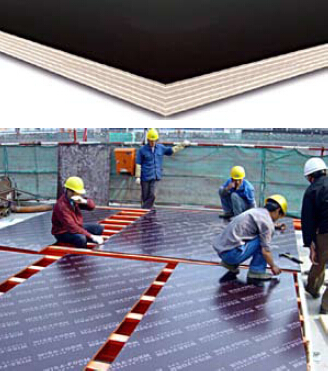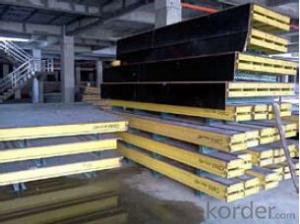Plywood Formwork Systems for Formwork and Scaffolding
- Loading Port:
- Tianjin
- Payment Terms:
- TT OR LC
- Min Order Qty:
- 50 m²
- Supply Capability:
- 1000 m²/month
OKorder Service Pledge
Quality Product, Order Online Tracking, Timely Delivery
OKorder Financial Service
Credit Rating, Credit Services, Credit Purchasing
You Might Also Like
Plywood --- make perfect concrete surface
WISA-Form Birch is a coated special plywood using in the formwork systems where high
requirements are set on the concrete surface and the times of reuses.
With CNBM timber beam & WISA plywood, the formwork is low weight but high load capacity, it is
widely used in construction.
Characteristics:
◆ Component with high standardization.
◆ Assembling in site, flexible application.
◆ Light weight, easy transportation and storage.


- Q:Can steel formwork be used for both above-ground and below-ground structures?
- Yes, steel formwork can be used for both above-ground and below-ground structures.
- Q:Can steel formwork be used for stadium construction projects?
- Certainly! Stadium construction projects can utilize steel formwork. Steel formwork involves the use of steel panels and frames to construct temporary molds or structures for pouring concrete. Due to its durability, strength, and reusability, this method is widely employed in various construction projects, including stadium construction. When constructing stadiums, there is often a need for extensive concrete pouring for different elements such as foundations, beams, columns, and slabs. Steel formwork provides the essential support and stability during the concrete pouring phase, ensuring accurate and precise concrete placement. Furthermore, steel formwork can withstand the immense pressures involved in concrete pouring, making it suitable for large-scale stadium projects. Steel formwork presents several advantages over traditional materials like timber or plywood. Firstly, it is highly durable and can be utilized for multiple construction cycles, resulting in long-term cost-effectiveness. Secondly, steel formwork offers superior dimensional accuracy and consistency, leading to the creation of high-quality concrete structures. Additionally, steel formwork is fire-resistant, weather-resistant, and easy to clean and maintain. Moreover, steel formwork can be tailored and fabricated to meet the specific design requirements of the stadium. This flexibility allows for efficient and precise construction, ensuring that the structural elements of the stadium meet the desired specifications. In conclusion, steel formwork proves to be a suitable and preferred choice for stadium construction projects. Its strength, durability, reusability, and customization options make it an ideal solution for creating temporary molds and structures during the concrete pouring process.
- Q:How does steel formwork accommodate for different concrete compaction methods?
- Steel formwork is an adaptable construction material capable of accommodating various concrete compaction methods with ease. Its strength and rigidity are key advantages, allowing it to withstand the forces exerted during compaction techniques. When utilizing compaction methods such as hand tamping or a vibrating poker, steel formwork provides a stable and secure surface for applying the necessary forces. The rigid and tightly connected steel panels ensure that the concrete remains in place and maintains its shape throughout the compaction process. This facilitates efficient and effective compaction, resulting in a uniform and high-quality concrete finish. In instances where mechanical compaction methods such as plate compactors or vibrating rollers are employed, steel formwork readily adapts to the added weight and vibrations. The robustness of the steel panels enables them to support heavy equipment and absorb vibrations without deformation or cracking. This guarantees even compaction of the concrete, eliminating any potential weak spots or voids. Moreover, steel formwork can be easily adjusted and modified to accommodate diverse compaction methods. The panels can be effortlessly repositioned or removed to allow proper access and movement for compaction equipment. Additionally, steel formwork can be tailored to specific shapes and sizes to meet the requirements of the compaction method employed. In summary, steel formwork offers a dependable and flexible solution for accommodating various concrete compaction methods. Its strength, rigidity, and adaptability make it an ideal choice for construction projects that necessitate efficient and effective compaction techniques.
- Q:What are the different types of steel formwork supports?
- There are several different types of steel formwork supports that are commonly used in construction projects. Some of the main types include: 1. Adjustable Steel Props: These are vertical supports that can be adjusted to desired heights. They are made of steel tubes with an adjustable inner and outer tube, allowing for easy height adjustment. Adjustable steel props are commonly used to support horizontal formwork or scaffolding systems. 2. Soldier Formwork System: This type of steel formwork support consists of vertical steel members known as soldiers that are spaced at regular intervals along the formwork. Soldiers are designed to resist the lateral pressure of wet concrete and provide support to the formwork panels. 3. Trench Struts: Trench struts are used to support and stabilize formwork in trenches or excavations. They consist of steel tubes with adjustable length and are typically used in conjunction with steel walers or beams to create a sturdy framework for the formwork. 4. H-Frame Systems: H-frame systems are commonly used for vertical formwork supports. They consist of steel frames in the shape of an "H" that are connected together to create a stable structure. H-frame systems are often used for supporting vertical formwork panels or as a framework for climbing formwork systems. 5. Steel Waler: A steel waler is a horizontal member used to support the formwork panels. It is typically made of steel channels or beams and is used in conjunction with vertical supports like adjustable steel props or trench struts. These are just a few examples of the different types of steel formwork supports that are commonly used in construction. The choice of support system depends on the specific requirements of the project, such as the formwork design, load capacity, and desired adjustability.
- Q:Are there any health concerns associated with steel formwork?
- Yes, there are potential health concerns associated with steel formwork. These concerns mainly revolve around the use of hazardous chemicals such as paints, coatings, or sealants that may contain volatile organic compounds (VOCs). Prolonged exposure to these VOCs can lead to respiratory issues and other health problems. Additionally, the handling of heavy steel formwork components can pose risks of musculoskeletal injuries if proper safety measures are not followed. It is important to ensure proper ventilation, use protective gear, and follow safety guidelines to mitigate these health concerns.
- Q:How is steel formwork used in construction projects?
- Steel formwork is commonly used in construction projects as a temporary mold or framework to hold wet concrete in place until it sets and hardens. It provides the necessary support and shape for the concrete, allowing it to be poured and molded into desired structures such as walls, columns, beams, and slabs. Steel formwork offers durability, strength, and reusability, making it a preferred choice for large-scale projects that require high-quality finishes and precise dimensions.
- Q:How does steel formwork affect the overall dimensional stability of a structure?
- Steel formwork can significantly enhance the overall dimensional stability of a structure. Due to its strength and rigidity, steel formwork provides excellent support to the concrete during the pouring and curing process. This ensures that the structure maintains its desired shape and dimensions without any significant deformation or dimensional changes. Additionally, steel formwork has minimal expansion and contraction properties, which further contributes to the stability of the structure. Overall, the use of steel formwork helps in achieving accurate and consistent dimensions, resulting in a structurally sound and stable building.
- Q:What are the features of the new building template?
- On the basis of all steel construction formwork, the surface of the template is extremely smooth, and can reach the international standard of fair faced concrete
- Q:Can steel formwork be used for both slab and beam construction?
- Indeed, steel formwork is applicable for both slab and beam construction. Within the construction industry, steel formwork proves to be a flexible and long-lasting alternative for constructing slabs and beams. It furnishes a robust and inflexible framework that can endure the weight and pressure exerted by the poured concrete. With easy assembly and disassembly, steel formwork emerges as a fitting choice for diverse construction undertakings. Its sturdiness and steadiness render it an optimal selection for both slab and beam construction, guaranteeing that the concrete structures adhere to the necessary specifications and can adeptly bear the loads they are designed for.
- Q:Can steel formwork be used for concrete stairs?
- Yes, steel formwork can be used for concrete stairs. Steel formwork provides a durable and strong structure that can support the weight of concrete and ensure the stability of the stairs during construction. It offers flexibility in terms of design and can be easily adjusted to accommodate different stair dimensions and configurations. Additionally, steel formwork allows for efficient and precise construction, resulting in high-quality concrete stairs.
1. Manufacturer Overview |
|
|---|---|
| Location | |
| Year Established | |
| Annual Output Value | |
| Main Markets | |
| Company Certifications | |
2. Manufacturer Certificates |
|
|---|---|
| a) Certification Name | |
| Range | |
| Reference | |
| Validity Period | |
3. Manufacturer Capability |
|
|---|---|
| a)Trade Capacity | |
| Nearest Port | |
| Export Percentage | |
| No.of Employees in Trade Department | |
| Language Spoken: | |
| b)Factory Information | |
| Factory Size: | |
| No. of Production Lines | |
| Contract Manufacturing | |
| Product Price Range | |
Send your message to us
Plywood Formwork Systems for Formwork and Scaffolding
- Loading Port:
- Tianjin
- Payment Terms:
- TT OR LC
- Min Order Qty:
- 50 m²
- Supply Capability:
- 1000 m²/month
OKorder Service Pledge
Quality Product, Order Online Tracking, Timely Delivery
OKorder Financial Service
Credit Rating, Credit Services, Credit Purchasing
Similar products
New products
Hot products
Hot Searches
Related keywords
























